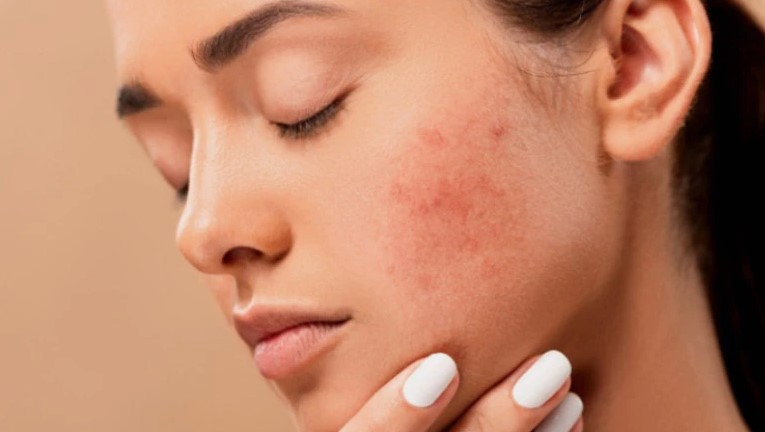Sometimes less is more.
For the past decade, we’ve heard the same skincare advice over and over: exfoliate several times a week, increasing the frequency as you age to keep your skin smooth and glowy. But as skincare knowledge and products have evolved, so have approaches to maintaining beautiful, healthy skin. Whereas a few decades ago, skincare was all about deep cleansing and scrubbing, nowadays, adopting a gentler strategy is often recommended.

So… should you still be exfoliating? And if so, how often? Here’s why the practice is so popular and how to reevaluate your skincare habits.
What Is Exfoliation?
“Exfoliation is the process of removing the buildup of superficial dead skin cells from the outermost layer of the skin,” explains celebrity aesthetician, Gina Marí – one of the most in-demand skincare experts in the country. There are two types of exfoliation: physical and chemical. Physical—sometimes called “mechanical”—is done using a face scrub product that contains small, gentle beads or a tool with a rough surface, like a washcloth or an exfoliation glove.
The other type of exfoliation, which has become increasingly well-known and loved in the past years, are chemical exfoliators such as skin care products that contain acids like AHAs, BHAs, and PHAs (alpha-hydroxy acids, beta hydroxy acids and polyhydroxy acids). You’ll find them in different concentrations in peels, masks, toners, serums, and moisturizers, cleansers, as well as body products, and even scalp treatments.
Exfoliation Perks
There are many, which is likely why it’s taken up so much space in our skincare routines over the past while. “Exfoliation can help improve the appearance of skin tone, fine lines, wrinkles, along with lightening pigmentation, unclogging pores (helping to diminish blackheads and pimples), and allowing for deeper product penetration,” says Marí. As you age, your skin cell turnover slows, which makes exfoliation particularly interesting as part of your skincare strategy.

… And Disadvantages
However, if you exfoliate too frequently, it can compromise your skin barrier, especially if you have sensitive skin, which can lead to not-so savory signs of over-exfoliation like loss of hydration, acne breakouts, or irritation. It can also affect your skin’s microbiota, which is essentially a layer of microscopic organisms that live on your skin and help protect it and keep it healthy. “Over-exfoliating can lead to flaky, dehydrated, and dry skin,” says Marí. Exfoliation also makes you more sensitive to sun damage since you’re essentially removing its outer layer and exposing new skin. According to Marí, exfoliating too aggressively can also “most definitely cause broken capillaries.”
What To Do If You’ve Over-Exfoliated
If your skin feels raw, is flaking, more prone to dryness, has been reacting to products or ingredients it doesn’t usually, or feels uncharacteristically dry or dehydrated, you may have over-exfoliated. Try giving your skin a break from anything containing ingredients like glycolic acid, lactic acid, salicylic acid, or any other AHAs, BHAs, or PHAs. You may also want to lay off physical scrubs for a while.
Instead, opt for gentle, moisturizing products with ingredients that help soothe and repair the skin (Centella Asiatica, snail mucin, squalane, and niacinamide are your friends) and give your skin a chance to chill for a few days or weeks if necessary. Once your skin has calmed down, try slowly reintroducing exfoliators into your routine, paying very close attention to your skin in the process.

To Exfoliate Or Not To Exfoliate
Some beauty experts and dermatologists claim exfoliation isn’t necessary, as the skin does it naturally over the span of roughly one month. When you use your favorite peel or scrub, it simply helps this process along. The key is to figure out an exfoliation frequency and strategy that takes things like your skin type, the time of year, and what type of climate you live in into account to ensure you don’t overdo it.
“Skin type absolutely needs to be addressed when deciding which type of product to use,” warns Marí. Depending on whether you have dry, oily, or combination skin, the frequency will also vary—but “thicker or oilier skin types generally benefit from exfoliating around two to three times a week,” she says. Remember to avoid direct exposure to the sun and always use a daily sunscreen (along with wearing a hat), especially while using exfoliating products.
Marí also insists on the importance of following product directions: for example, if the label says to leave an AHA peel on for one minute, waiting an extra five won’t yield better results. “Instead, you run the risk of stripping your skin of its natural moisture factors and possibly wearing down its microbiome,” she says. She also highly recommends applying toner immediately after exfoliating and then following up with a hydrating serum featuring hyaluronic acid or a moisturizer with lipids, skin’s natural fats.
If you do want to exfoliate your skin and are still unsure of the ideal product or strategy, Marí says consulting an esthetician or dermatologist is best.
How often do you exfoliate your skin? Have you ever had any experiences with over-exfoliation? Share below!
Loading...